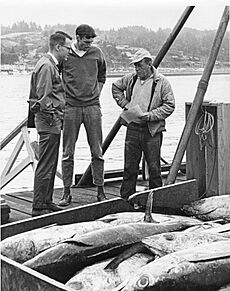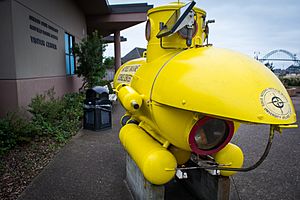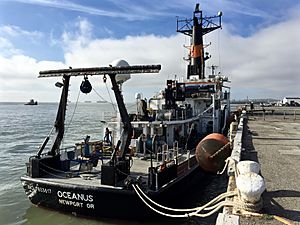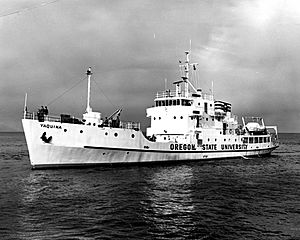Hatfield Marine Science Center facts for kids
Quick facts for kids Hatfield Marine Science Center |
|
|---|---|
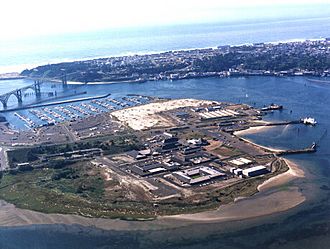
Campus on Yaquina Bay
|
|
| General information | |
| Location | Lincoln County, Oregon |
| Country | United States |
| Coordinates | 44°37′09″N 124°02′44″W / 44.61917°N 124.04556°W |
| Opened | 1965 |
The Hatfield Marine Science Center (HMSC) is a cool place where scientists study the ocean and teach others about it. It's located right next to Yaquina Bay in Oregon, near the Pacific Ocean. Oregon State University runs HMSC, working with several government groups. The center is named after Mark Hatfield, who was a U.S. Senator from Oregon. HMSC covers a big area, about 49 acres, in Newport.
Contents
History of HMSC
The Hatfield Marine Science Center first opened its doors in 1965. Before HMSC, there was a smaller lab called the Yaquina Bay Fisheries Laboratory. That lab started way back in 1939 on the other side of Yaquina Bay.
A new building, the Gladys Valley Marine Studies Building (MSB), was finished in the summer of 2020. This building has new offices and labs. It also has a large auditorium that can seat 250 people and a cafe. The MSB is super strong! It's built to be a safe place for over 900 people, including local residents, if a tsunami or a very strong earthquake happens.
Who Works at HMSC?
More than 300 people work at the Hatfield Marine Science Center. These include professors, students, and researchers from Oregon State University. Staff from different government agencies also work there. Some of these agencies are the Oregon Department of Fish and Wildlife, the U.S. Fish and Wildlife Service, and the National Oceanic and Atmospheric Administration (NOAA). They all work together to learn more about the ocean.
Visit the Center!
The Hatfield Marine Science Visitor Center is a special part of HMSC that's open to everyone. It's a great place to learn about ocean animals, marine research, and the coast. You can see many cool exhibits and even join public programs and tours. The visitor center is open all year, and you can pay what you wish to enter.
Inside, you can see live ocean animals, like a huge Giant Pacific octopus. You can even watch the octopus from home using the HMSC OctoCam! Other exhibits teach you about weather, tsunamis, and how people fish. You can also learn about tiny sea creatures and animals that live in tide pools. Outside the center, you can see the Newmas. This is a 13-foot-long submersible (a small underwater vehicle) that two people could ride in.
Learning at HMSC
Students who are in college and those studying for advanced degrees come to HMSC to learn. The new Gladys Valley Marine Studies Building was designed to host about 500 college students all year long.
Research Teams
HMSC is home to many research teams that work together. These teams include Oregon State University and other organizations.
- The Cooperative Institute for Marine Resources Studies (CIMRS) studies many things. They look at fishing, how to raise sea animals (aquaculture), ocean environments, and climate. They also study ocean currents, geology, and technology for ocean resources.
- The Coastal Oregon Marine Experiment Station (COMES) helps Oregon's fishing and seafood industries. They do research and development to support coastal communities. COMES is the biggest of 12 similar research stations in Oregon.
- The Marine Mammal Institute (MMI) focuses on marine mammals like whales and seals. They study how these animals live, their genes, and their health.
- The Northwest National Marine Renewable Energy Center (NNMREC) is a team from Oregon State University and the University of Washington. They study how to get energy from ocean waves and tides.
- The Northwest Association of Networked Ocean Observing Systems (NANOOS) collects information about the ocean. They work with the U.S. Environmental Protection Agency to monitor data from Yaquina Bay.
Research Ships
Oregon State University has two research ships that sail from a port next to HMSC. Also, the NOAA Marine Operations Center-Pacific (MOC-P) is right next to HMSC. This is where the NOAAS Bell M. Shimada and the NOAAS Rainier ships are based. Scientists at HMSC often use these ships for their research.
Current Vessels
- R/V Taani – This ship is 199 feet long and was finished in 2023.
- R/V Oceanus – This ship is 177 feet long.
- R/V Elakha – This ship is 54 feet long.
Retired Vessels
- R/V Acona
- R/V Cayuse – This ship was 80 feet long.
- R/V Wecoma – This ship was 184.5 feet long.
- R/V Yaquina – This ship was 180 feet long.
Leaders at HMSC
- Bob Cowen (2013 – Present)
- George Boehlert (2002 – 2012)
- Lavern Weber (1977 – 2002)
- John Byrne (1972 – 1977)
See also
- Oregon Coast Aquarium, a nearby place to visit in Newport, Oregon
- Sea Lion Caves, another nearby place to visit near Florence, Oregon
- Oregon Institute of Marine Biology, a similar place run by the University of Oregon
- Moss Landing Marine Laboratories, a group of marine research labs in California
- Hopkins Marine Station, a research place run by Stanford University in Monterey, California
- Scripps Institution of Oceanography, a research place in La Jolla, California
- Woods Hole Oceanographic Institution, a research place in Woods Hole, Massachusetts


